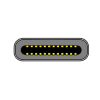2
High Trust ProductsChargers and Power Banks
Headphone & Speakers
Cases & Covers
Virtual Reality
Cables & Adapters
Media Player
Laptop
Tablet
Desktop
Cell Phone
Printers & Copiers
Memory Cards
TV
Computer Display
Game Console
Smart Home
Wearable Technology
Photo & Video Camera
Car Electronics
Car
Networking Equipment
Smart Toys
Home Audio & Video
Professional & Industrial
Storage Drive
Docking Station
Game Console Controllers
Set-top box
Keyboard, Mice, & Stylus
Portable Music Player
Computer Parts & Components
Cordless & Speakerphones
Projector
Software
Reporting
Galaxy Note9
by Samsung









Interested in this product?

Select a product category to see which devices type we recommend to use with the Galaxy Note9:
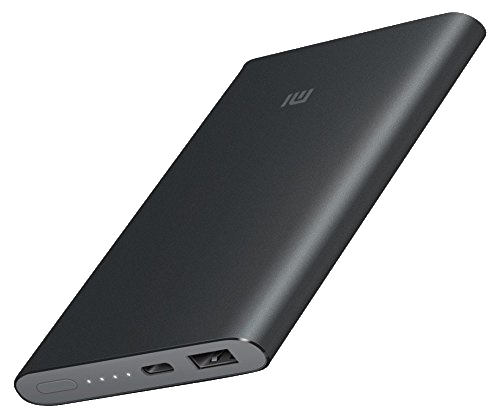
Samsung's Galaxy Note9 is Basically a Much More Expensive Version of the Galaxy Note8
To compete with Apple's iPhone XS and iPhone XS Max and Google's Pixel 3 and Pixel 3 XL, Samsung went on to release its latest Galaxy phones like the Galaxy Note9 and Galaxy S9+. The Samsung Galaxy Note 8 was previously released to a well received audience and the Samsung Galaxy Note9 hopes to achieve similar success by keeping closely to the Note 8's quality specs and features. Besides supporting Samsung's own proprietary Adaptive Fast Charging technology, the Samsung Galaxy Note9 can also use USB Power Delivery 2.0 technology for rapid charging over the USB Type-C connector similar to the Samsung Galaxy Note 8. Both phones also enable Qi based wireless charging, joining other Qi adopters like Google's Pixel 3 and Pixel 3 XL, Apple's iPhone XS and iPhone XS Max, LG G7 ThinQ, and Sony Xperia XZ2 Premium.

The Samsung Galaxy Note9 comes with a upgraded Qualcomm Snapdragon 845 processor over Note 8's Qualcomm Snapdragon 835 although still only supporting Qualcomm Quick Charge 2.0 technology. The Samsung Galaxy Note9 runs on a newer Android 8.1 Oreo and has a more advanced Adreno 630 GPU, higher 8 GB RAM and 512 GB storage and a larger 4000 mAh battery compared to its predecessor.
Here's a quick view of how the Samsung Galaxy Note9 looks like from inside the packaging.
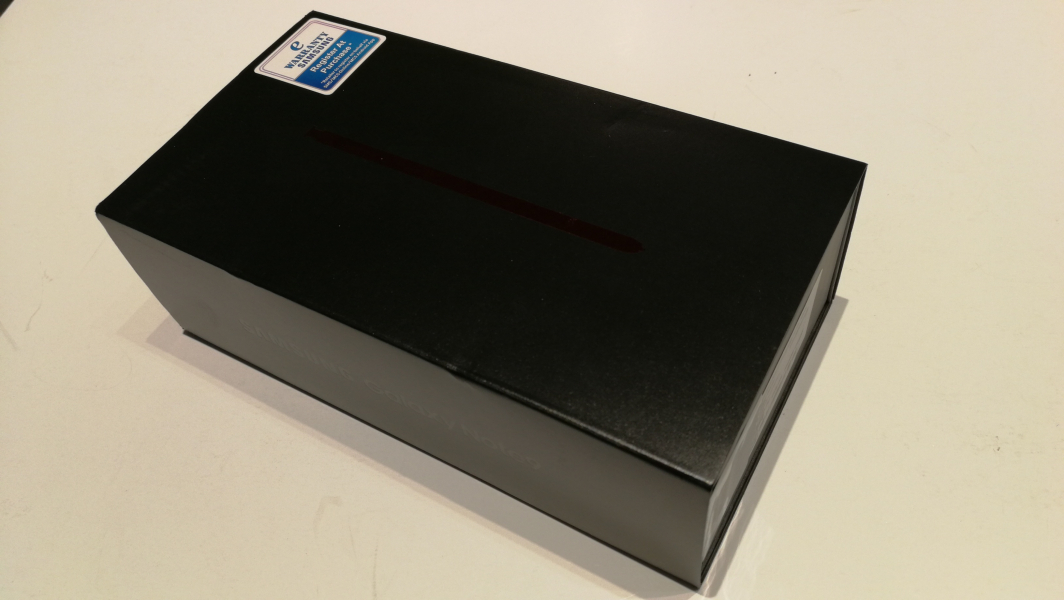
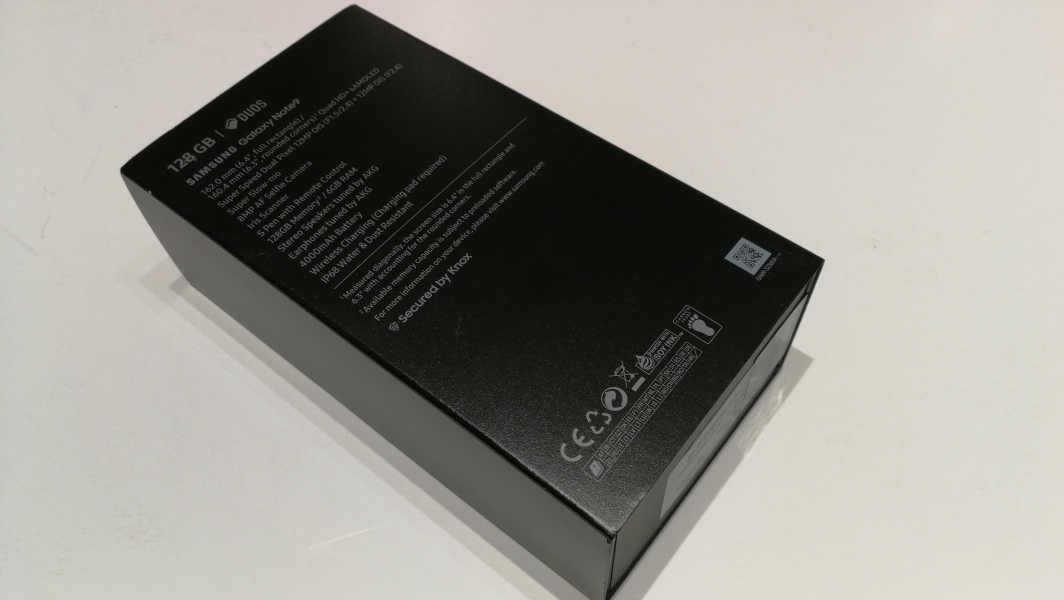
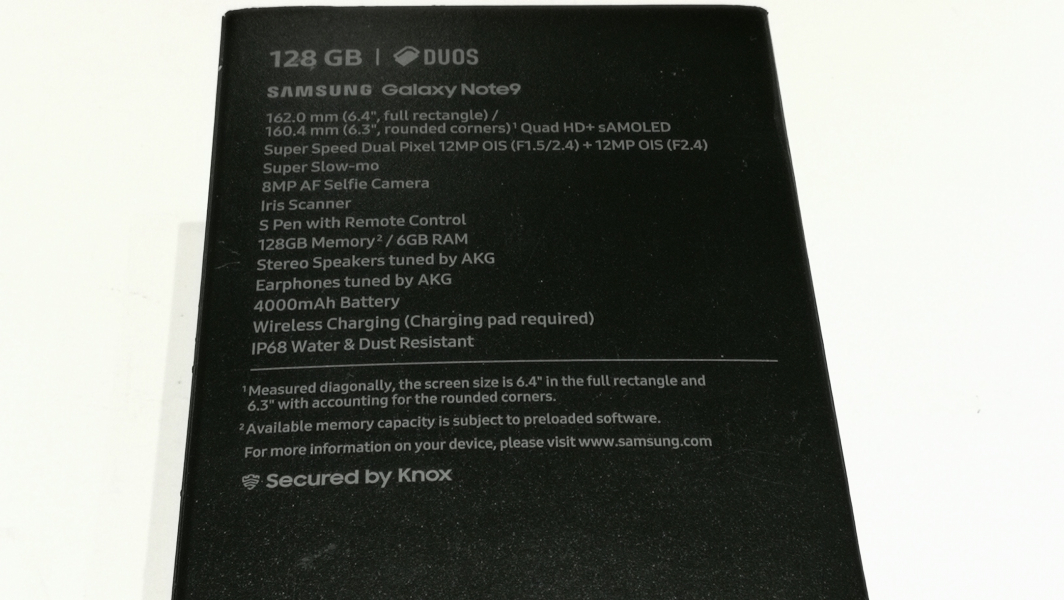
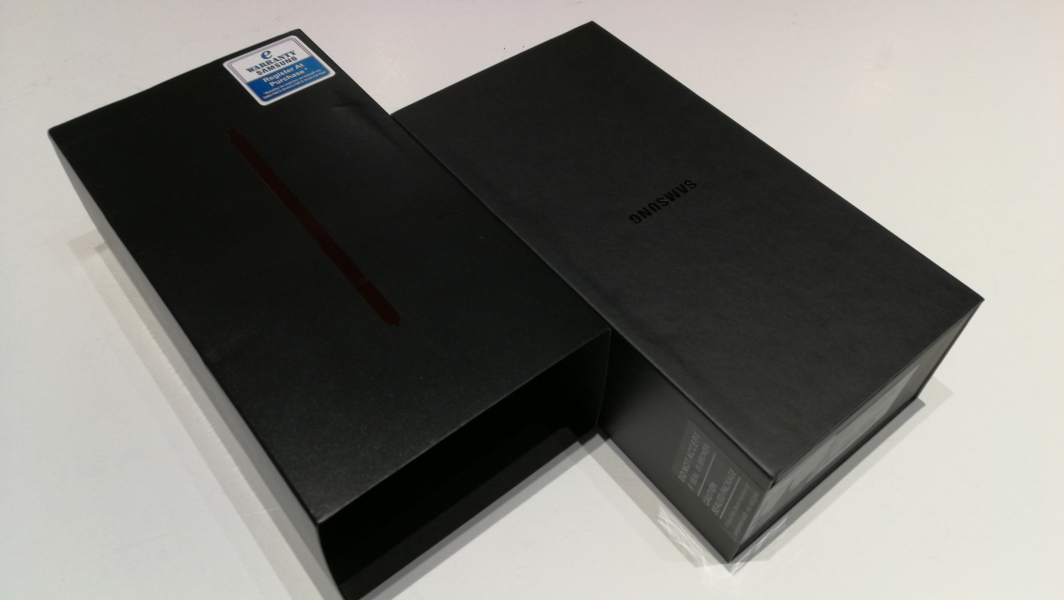

Opening up the box gives off a nice elegant feel to the phone as also seen previously with other Samsung premium flagships like the Note 8 (in this review).
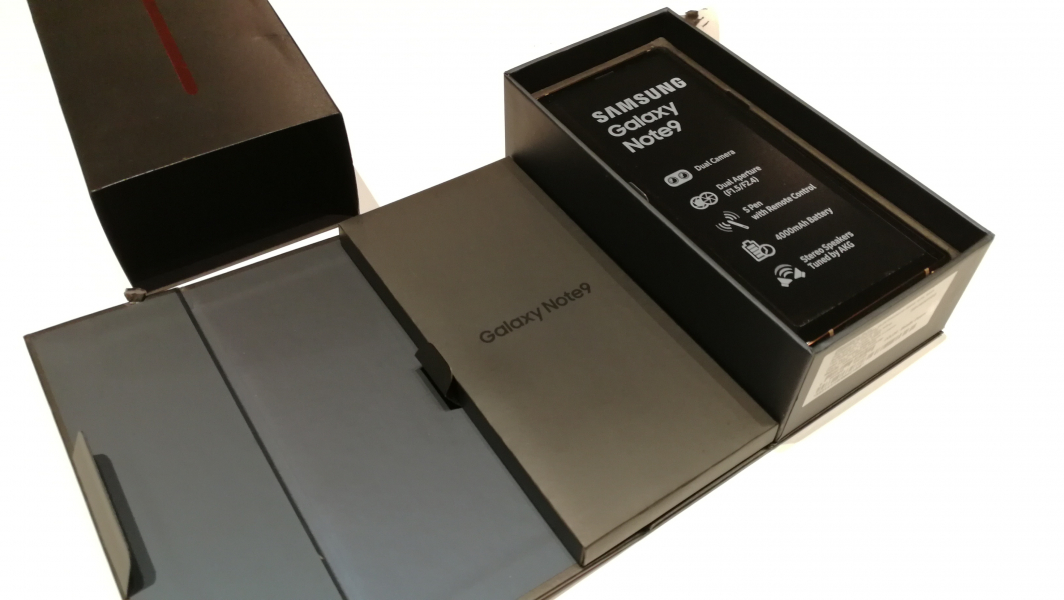
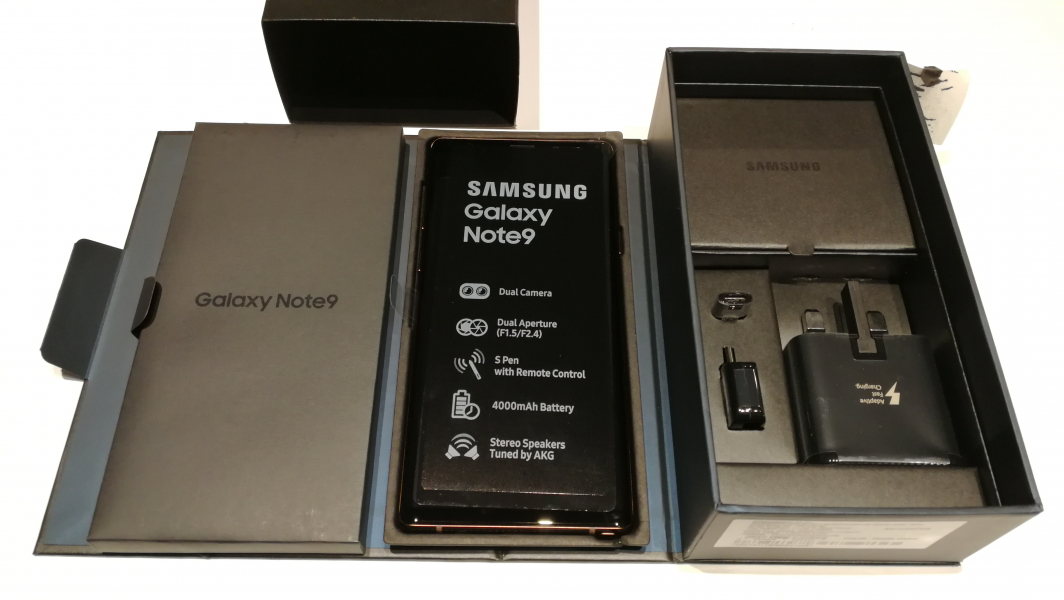
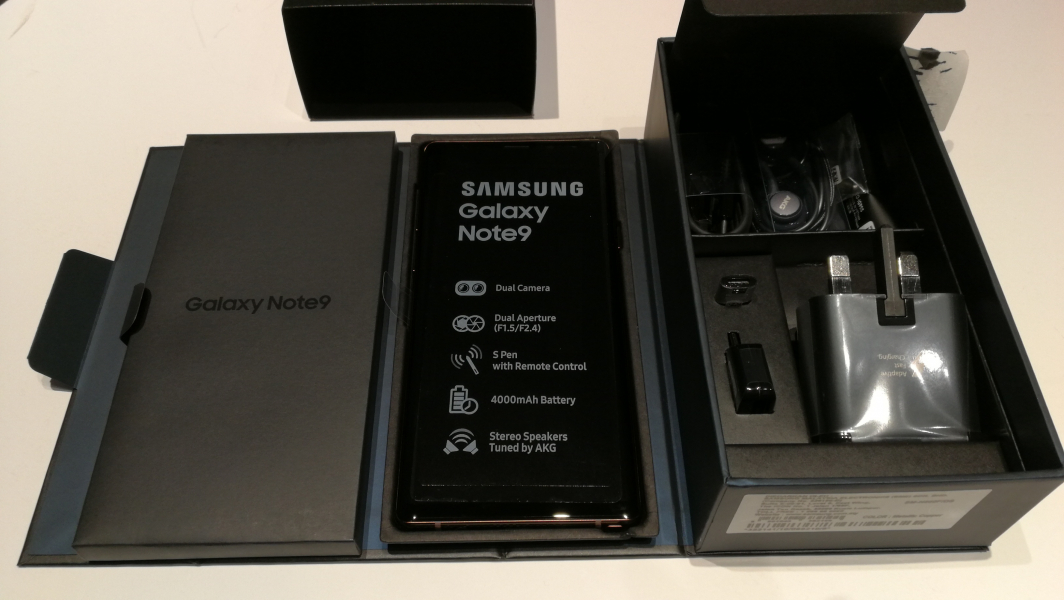
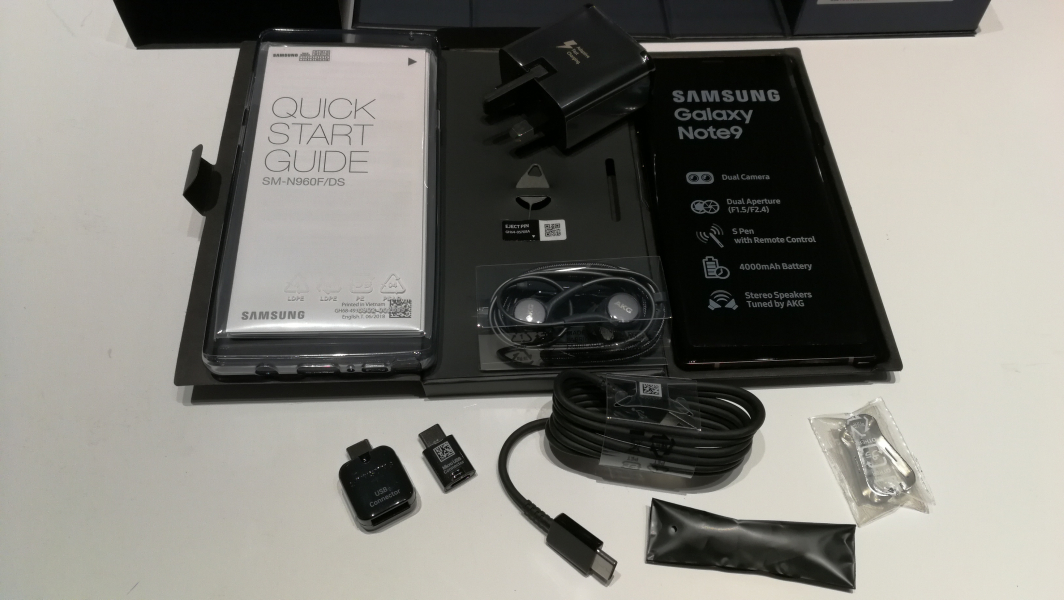
Similar to the Samsung Galaxy Note 8, the Samsung Galaxy Note9 came with a bunch of accessories that include a Samsung Adaptive Fast Charger, USB Type-A to USB Type-C cable, ear buds, USB Type-C to USB Micro-B adapter, USB Type-C to USB Type-A adapter, S Pen, pen nibs, ejection pin, tweezer, casing, and some documentation. The S Pen is now better equipped than the one that ships with the Note 8 to offer more capabilities such as allowing remote access to apps on the phone.
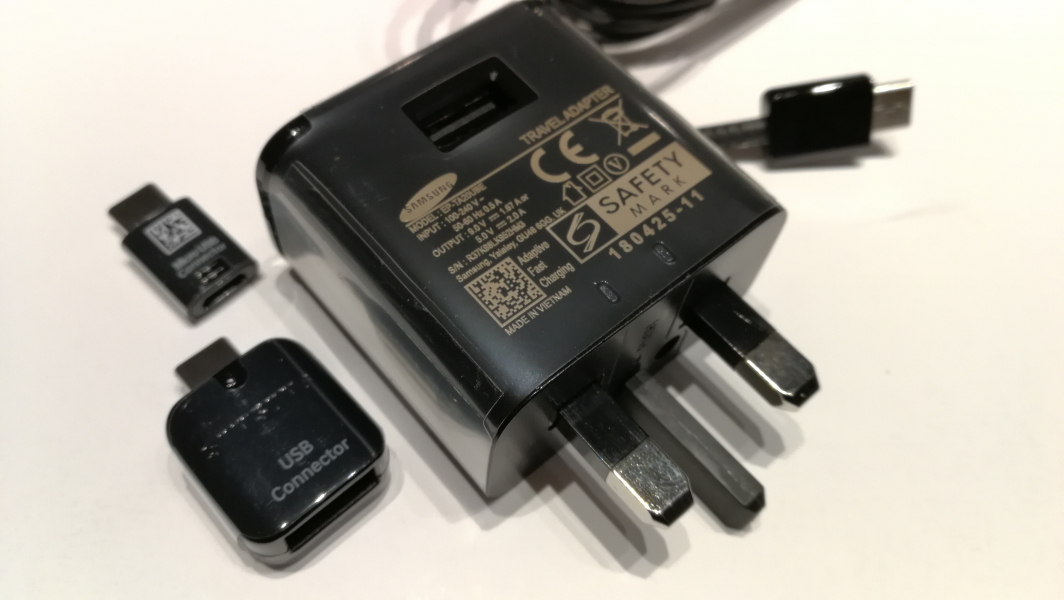
The Samsung Galaxy Note9 is given a 15W USB Type-A Adaptive Fast Charger that makes use of its own Samsung proprietary charging scheme to quickly charge the phone when connected using the supplied USB Type-A to USB Type-C cable. The charger supports the same power profiles of 15 watts (9 volts @ 1.67 amps) and 10 watts (5 volts @ 2 amps) for charging as the Samsung Galaxy Note 8's charger.

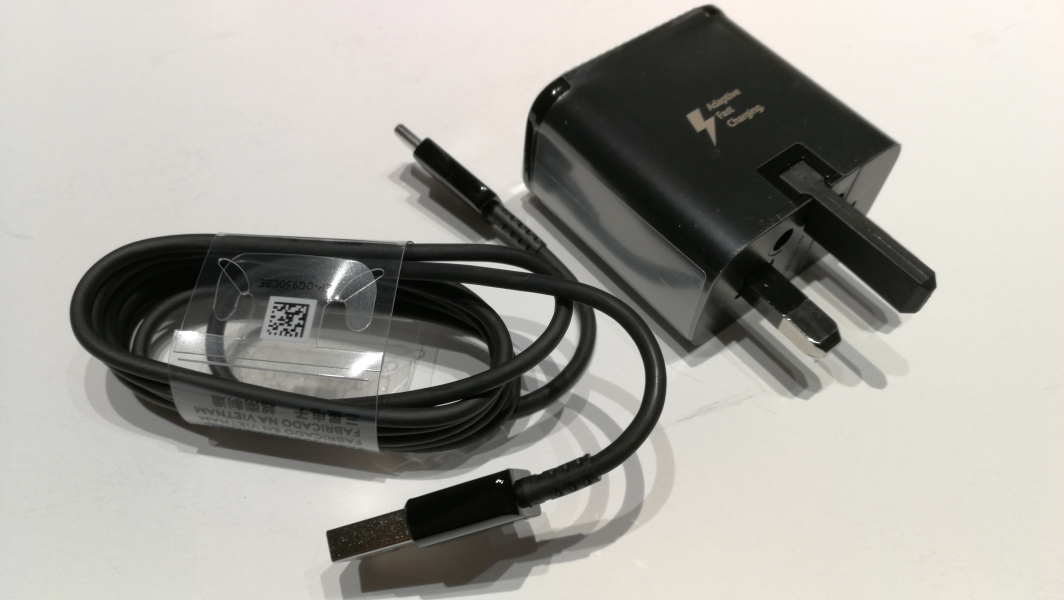
Style-wise the Samsung Galaxy Note9 still retains most of the previous design and features including the front and dual 12MP rear camera and the 3.5mm audio jack. The phone now has the fingerprint sensor below rather than on the side of the rear camera which is more easily accessible.
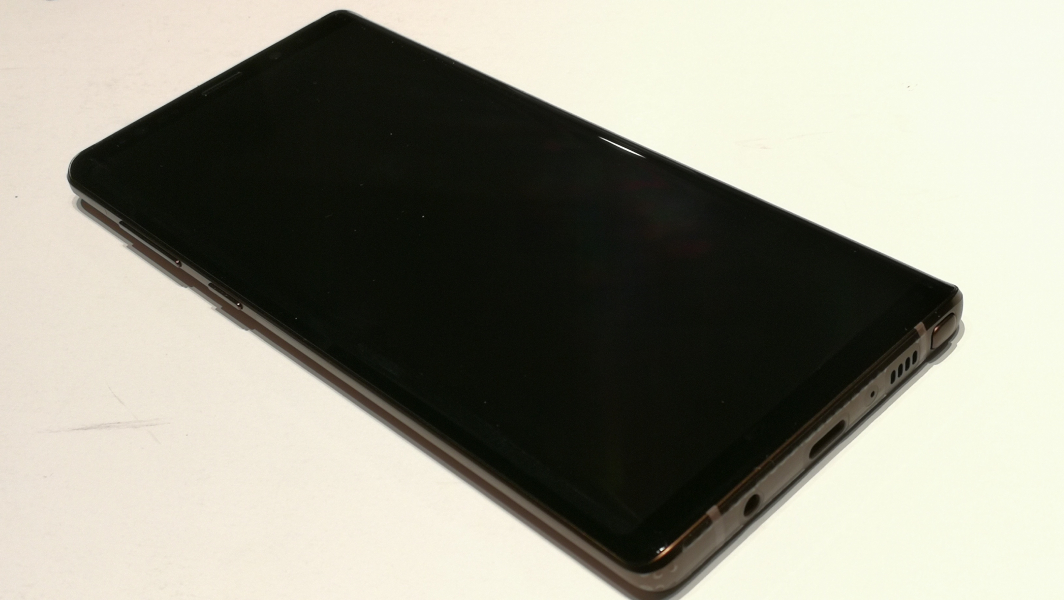
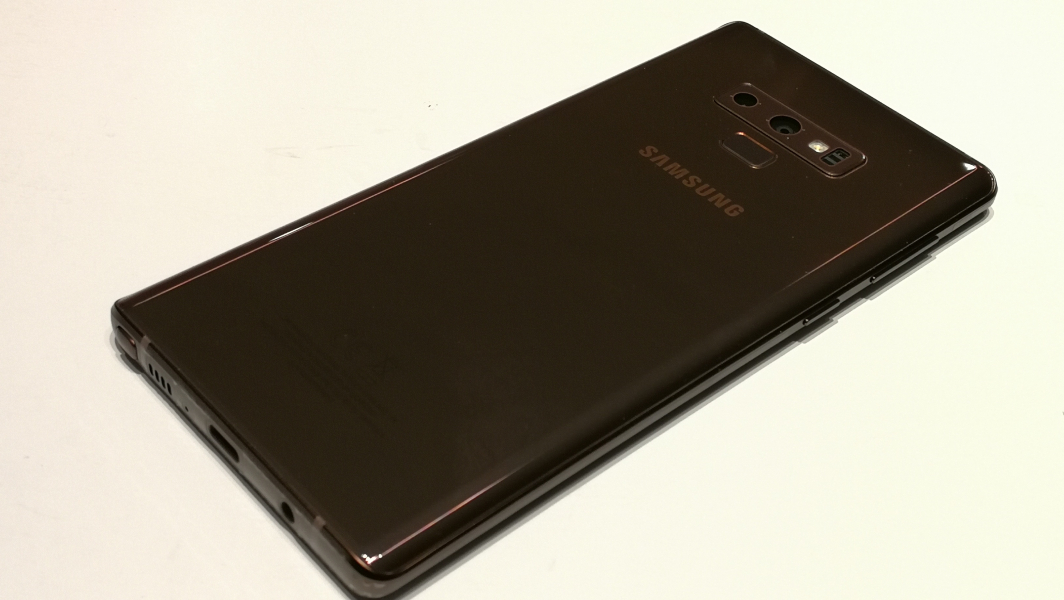
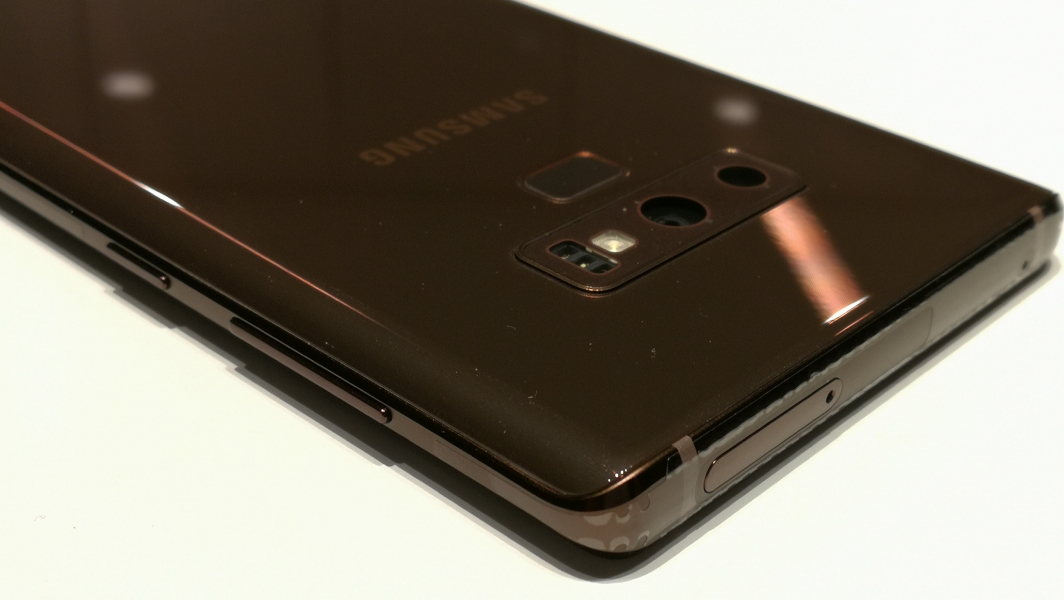

The Samsung Galaxy Note9 uses the same USB Type-C connector as the Samsung Galaxy Note 8 and more recent Galaxy models like the Samsung Galaxy S9+ and Galaxy S8 that enables both USB Power Delivery based charging and video output using DisplayPort Alternate Mode. The USB Type-C connector supports USB 3.1 Gen 1 (5 Gb/s) speeds which are also supported by other USB Type-C phones like the Lumia 950, HTC 10, Lenovo's ZUK Z1, Zuk Z2 Pro, and Moto Z Droid.


The Samsung Galaxy Note9 should cater well for Note fans who can take advantage of the useful note features of the phone as long as they don't mind spending as much as buying the latest Apple iPhone.
Using the USB Power Test App from Granite River Labs with the Granite River Labs USB Power Delivery Compliance C2 Tester, we performed the following tests for the Samsung Galaxy Note9.
The USB Power Test App first negotiates a power contract emulating the Source to determine the Power Delivery Sink capabilities of the Samsung Galaxy Note9. The USB Power Test App then reports out the voltage and current supported by the Samsung phone for each of the Source PDO's advertised to the phone. The phone consumes a similar 14-15W power level with both Samsung's own Adaptive Fast Charging and USB Power Delivery technology (click here to see how the phone charges using Samsung's AFC).
| Sink Cap. | Voltage (V) | Current (A) |
|---|---|---|
| 5V | 5.09 | 2.46 |
| 6V | 5.07 | 2.37 |
| 7V | 5.1 | 2.47 |
| 8V | 5.05 | 2.37 |
| 9V | 5.06 | 2.37 |
| 10V | 5.09 | 2.37 |
| 11V | 5.06 | 2.37 |
| 12V | 5.07 | 2.36 |
| 13V | 5.09 | 2.36 |
| 14V | 5.05 | 2.36 |
| 15V | 5.07 | 2.37 |
| 16V | 5.07 | 2.37 |
| 17V | 5.07 | 2.37 |
| 18V | 5.06 | 2.37 |
| 19V | 5.09 | 2.36 |
| 20V | 5.1 | 2.37 |
The USB Power Test App from Granite River Labs also produces a voltage, current trace plot which graphically shows the voltage and current requested by the phone for each advertised Source PDO throughout the power negotiation.
Using the USB Power Delivery Compliance C2 Tester from Granite River Labs to run just a subset of the full USB Power Delivery compliance test suite, we can see that the Samsung Galaxy Note9 supports fixed PDO's of 2.5 watts (5 volts @ .5 amps), 15 watts (5 volts @ 3 amps) and 18 watts (9 volts @ 2 amps) as well as variable power supply of 10-18 watts range (5-9 volts @ 2 amps) for charging. Note a compliance failure was observed.
Power Capabilities
Parameter
|
GetCapabilities
|
|---|---|
NUM_SRC_PDOS
|
1
|
Supply Type #1
|
Fixed
|
Peak Current #1
|
0x0(A)
|
Voltage #1
|
0x64(5V)
|
Max Current #1
|
0x32(.5A)
|
NUM_SNK_PDOS
|
3
|
Supply Type #1
|
Fixed
|
Voltage #1
|
0x64(5V)
|
OP Current #1
|
0x12C(3A)
|
Supply Type #2
|
Fixed
|
Voltage #2
|
0xB4(9V)
|
OP Current #2
|
0xC8(2A)
|
Supply Type #3
|
Variable
|
Min Voltage #3
|
0x64(5V)
|
Max Voltage #3
|
0xB4(9V)
|
Op Current #3
|
0xC8(2A)
|
USB-IF High Level Mapping Summary
Sl No
|
Test Category
|
Test Group Description
|
Test Result
|
|---|---|---|---|
1
|
PHY_PRIMARY_TX
|
BMC Physical Layer Transmitter
|
PASS
|
2
|
PHY_PRIMARY_RX
|
BMC Physical Layer Receiver
|
PASS
|
3
|
PHY_PRIMARY_MISC
|
BMC Physical Layer Miscellaneous
|
PASS
|
4
|
PROT_PRIMARY
|
Protocol Specific Primary
|
PASS
|
5
|
POWER_PRIMARY
|
Power Source/Sink Primary
|
FAIL
|
Result Summary
Sl No
|
Test ID
|
Test Name
|
Test Result
|
|---|---|---|---|
1
|
TDA.2.1.1.1
|
TDA.2.1.1.1 BMC PHY TX EYE
|
PASS
|
2
|
TDA.2.1.1.2
|
TDA.2.1.1.2 BMC PHY TX BIT
|
PASS
|
3
|
TDA.2.1.2.2
|
TDA.2.1.2.2 BMC PHY RX INT REJ
|
PASS
|
4
|
TDA.2.1.2.1
|
TDA.2.1.2.1 BMC PHY RX BUSIDL
|
PASS
|
5
|
TDA.2.1.3.1
|
TDA.2.1.3.1 BMC PHY TERM
|
PASS
|
7
|
TDA.2.2.1
|
TDA.2.2.1 BMC PROT SEQ GETCAPS
|
PASS
|
12
|
TDA.2.2.7
|
TDA.2.2.7 BMC PROT BIST NOT 5V SRC
|
PASS
|
14
|
TDA.2.2.9
|
TDA.2.2.9 BMC PROT GSC REC
|
PASS
|
15
|
TDA.2.2.10
|
TDA.2.2.10 BMC PROT IGN PPS
|
PASS
|
16
|
TDA.2.3.1.1
|
TDA.2.3.1.1 POW SRC LOAD P PC
|
FAIL
|
17
|
TDA.2.3.1.2
|
TDA.2.3.1.2 POW SRC LOAD CP ACC
|
PASS
|
20
|
TDA.2.3.3.1
|
TDA.2.3.3.1 POW SNK TRANS C CP
|
PASS
|
21
|
TDA.2.3.3.2
|
TDA.2.3.3.2 POW SNK TRANS PC
|
PASS
|
BMC Eye Diagram
Keep a lookout for coming reviews to see how we test the Samsung Galaxy Note9 with various devices using different technologies.
View Full Article
Featured Products
 GTrusted
GTrusted









